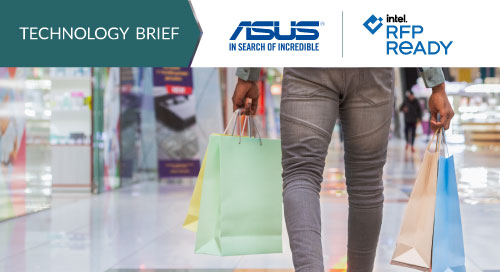Fill form to unlock content
Error - something went wrong!
Get the latest on IoT and network edge for retail.
You are following this topic.
POC Shows What’s In Store for Retail Analytics

Digital retailers make good use of the customer data they gather online. They are adept at using data analytics to provide a better customer service experience and target their future marketing. But the very nature of physical retailing has limited many of the data points that brick-and-mortar stores can easily track—until now.
Today, the latest AI and computer vision technologies allow retailers to gain insights into the buyer’s journey through the store—capturing information on traffic flow, foot traffic, dwell time, and product display interactions.
Combined with these customer insights, real-time retail analytics and reporting technologies are turning physical shops into smart retail stores. Operations and sales data such as store layouts, people management, and historical customer information provide retailers with insights they can leverage to personalize the customer experience and increase sales.
AI + Customization = Smart Retail
One technology that puts this all together is the ASUS Smart Retail Solution, a ready-to-go, AI-enabled, edge-to-cloud kit from ASUS, a computer hardware enterprise. It can be installed instantly and used as is, and there are also opportunities for systems integrators and retail businesses to customize the solution.
"We're providing a more friendly setup solution for users, with a general design to fit many retailing scenarios," says Iris Wang, a software planner at ASUS. "If the retailer needs customization, we're open to that and are capable of developing the API from the cloud back-end; we can have more discussion with SIs or retailers as needed."
The Smart Retail Solution has simple hardware requirements: an Intel® NUC “mini-PC” connected to cameras throughout a store. “We offer camera specifications for SIs and retailers as well as documentation on camera placement, including best angles for collecting specific types of video images,” says Wang. “The only technical knowledge an SI might need is learning to install the hardware devices, and understanding IP camera deployment. We provide related technical support, including documentation, installation guidelines, and consultations.”
The only technical knowledge an SI needs is learning to install hardware devices and understanding IP camera deployment. @asus
ASUS's Bold Proof of Concept: Its Own Stores
ASUS has implemented the Smart Retail Solution in its own stores in Taiwan and Southeast Asia, where it sells its notebook, smartphone, and other products. The company uses the tool to both enhance shopping experiences and to demonstrate the workability of the solution.
“We recognize that digitalization means retailers have to make an investment and change their way of doing business,” says Wang. “To have a ‘live’ proof-of-concept in our stores is very helpful for customers who want to see the solution in action before making a purchase decision.”
The company has installed the system in stores of varying sizes. “Smaller stores may need just two or three cameras with one device,” says Wang. “In larger stores, we've installed five or six devices with up to 20 IP cameras to collect video images. We can demonstrate our experience in deploying across a wide spectrum of store types and sizes.”
An easy-to-use dashboard monitors each store and can be viewed remotely. Managers can easily view different types of retail analytics information such as entrance and engagement rates, the last time a customer was in the store, how long they spent in a specific area, and so forth. They can then strategize ways to improve product displays, customer engagement, and promotions.
In addition to showcasing the POC, the ASUS retail team leverages the insights gained to benchmark stores against one another, identify opportunities for improvement, and learn from the highest-performing outlets. “They use it to test previous assumptions about locations and customer personas to plan out future retail expansions,” says Wang, “It’s also very helpful to measure and monitor the effects of changes to marketing strategies and tactics.”
AI Advances Marketing & Staffing Decisions
The ASUS solution offers three integrations in its standard kit. The first is a series of AI models developed for recognizing shopper demographics such as gender and age. Then there's an in-house algorithm for people-counting, and the third integration is a dashboard that quickly gives retail managers real-time and historical data in an easy-to-understand format.
Retail managers can devise strategies and make business decisions based on the analytics to improve engagement with their customers. Does the store attract more male or female customers? What's the busiest time of day? What product or service is the most popular? These data points allow for smart marketing and efficient staffing.
ASUS designed the Smart Retail software to work in the widest number of settings. “We used the Intel® OpenVINO™ Toolkit to optimize our AI models, so the pre-trained models are highly compatible with Intel® platform devices,” says Wang.
Safety Today, Business Intelligence for the Future
In today’s challenging environment, the ASUS solution can serve the multiple needs of store owners. For almost any new trend or emergency, ASUS can create a new AI model and simply push the software from the cloud. With the growing need to protect the health and safety of customers and staff, the system can recognize, for example, whether someone is wearing a mask or if a section of the store becomes too crowded.
And once the tech helps retailers steer successfully through a new retail ecosystem, it also lets them focus on business intelligence and analytics for a better understanding of what's going on. That makes for smart, data-driven, and profitable decisions. Says Wang: “We believe video analysis technology can be the key factor for a strong recovery and long-term retail success.”
This article was edited by Christina Cardoza, Associate Editorial Director for insight.tech.
This article was originally published on July 16, 2020.